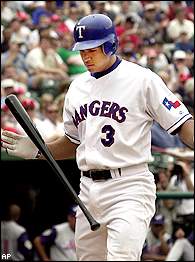« Archive for the ‘Player Salaries’ Category
posted by
Shawn, on October 1st, 2007 at 09:00 am, in category
Player Salaries,
RAS
Let’s pick on Tom Hicks for a bit.
 Last week we discussed the bubble that took hold in the player market in the late ‘90s and early ‘00s, and also determined that the current market still has room to grow. While there has been some tremendous work done on predicting player performance, little attention has been spent on forecasting the market. Why is this important? When dealing with long-term contracts, there are two questions a team must answer: how will this player perform, and how much will that level of play cost on the market through the life of the deal?
Last week we discussed the bubble that took hold in the player market in the late ‘90s and early ‘00s, and also determined that the current market still has room to grow. While there has been some tremendous work done on predicting player performance, little attention has been spent on forecasting the market. Why is this important? When dealing with long-term contracts, there are two questions a team must answer: how will this player perform, and how much will that level of play cost on the market through the life of the deal?
By 2000, MLB revenues had grown almost 140 percent over the previous decade. When the Rangers handed the keys to their castle to Alex Rodriguez, they likely expected revenues, and in turn player salaries, to keep skyrocketing at a similar rate. […]
posted by
Shawn, on September 24th, 2007 at 02:54 pm, in category
Player Salaries,
Revenues,
RAS
With baseball’s revenues growing at a blistering rate, it has become more and more difficult for analysts to accurately dissect big-money, multi-year signings. What we thought we knew just two years ago seems to be obsolete, with the market shifting upwards at breakneck speed.
Yes, we’ve seen this before. Culminating with the infamous winter of ’01, Major League payrolls rose between thirteen to nineteen percent annually for five consecutive years. Overall, teams spent almost four and a half times as much on player salaries in 2001 as they did in 1990.
With Armageddon warnings seemingly plastered on every team’s office walls, sensibility (or perhaps collusion) eventually resurfaced. Payrolls rose only moderately in 2002 and 2003, and actually declined a bit in 2004. The bubble had burst, leaving teams that had signed players to mega-deals in previous years shaking their heads, and/or calling Brian Cashman for a little relief. […]
 Last week we discussed the bubble that took hold in the player market in the late ‘90s and early ‘00s, and also determined that the current market still has room to grow. While there has been some tremendous work done on predicting player performance, little attention has been spent on forecasting the market. Why is this important? When dealing with long-term contracts, there are two questions a team must answer: how will this player perform, and how much will that level of play cost on the market through the life of the deal?
Last week we discussed the bubble that took hold in the player market in the late ‘90s and early ‘00s, and also determined that the current market still has room to grow. While there has been some tremendous work done on predicting player performance, little attention has been spent on forecasting the market. Why is this important? When dealing with long-term contracts, there are two questions a team must answer: how will this player perform, and how much will that level of play cost on the market through the life of the deal?